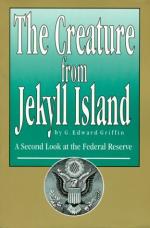
|
| Name: _________________________ | Period: ___________________ |
This quiz consists of 5 multiple choice and 5 short answer questions through Section I. What Creature Is This? Chapter 4 Home Sweet Loan.
Multiple Choice Questions
1. Who does the Federal Reserve depend on to bail out the country in times of economic collapse?
(a) The Federal Reserve turns to the banks to bail out the country in times of economic collapse.
(b) The Federal Reserve turns to the foreign investors to bail out the country in times of economic collapse.
(c) The Federal Reserve turns to the taxpayer to bail out the country in times of economic collapse.
(d) The Federal Reserve turns to Congress to bail out the country in times of economic collapse.
2. Why has bank fraud never been eliminated?
(a) The Federal Reserve was controlled by outside political interests that fostered fraud.
(b) Financial experts were taught that the way banking worked in the US was the only way it could work, and so the fraud kept on going.
(c) The Federal Reserve tried to institute European standards which led to the perpetuation of fraud.
(d) The Federal Reserve was influenced by lobbyists who advocated fraudulent regulations.
3. What is the main transport of both Amtrak and Conrail?
(a) Amtrak operates as a commuter train while Conrail operates as a long-distance carrier.
(b) Amtrak is the main carrier for government cargo and Conrail is available to the general public.
(c) Amtrak had been the passenger side of Penn Central, while Conrail had been the freight side.
(d) Amtrak had been the freight side of Penn Central, while Conrail had been the passenger side.
4. Why did banks make risky loans?
(a) The banks had incentive in terms of high profits for granting mortgages to home buyers who would not be able to pay the loans off, but who might be able to make interest payments.
(b) The US Congress passed legislation that required banks to make ten percent of their loans to risky borrowers.
(c) Banks are required by the Federal Reserve to make a certain percentage of risky loans.
(d) Banks did not thoroughly check out the risk factor of some borrowers.
5. What does the FDIC stand for?
(a) The FDIC stands for The Federal Deposit Insurance Corporation.
(b) The FDIC stands for The Federal Debt Issuers Company.
(c) The FDIC stands for The First Debt Institute of Connneticut.
(d) The FDIC stands for The First Depositor's Insurance Corporation.
Short Answer Questions
1. What was one of the strongest arguments in favor of bank regulation versus nationalization?
2. What is the definition of a public run on a bank?
3. When the entire banking system failed, what did the Federal government turn to to bolster the failed back up system?
4. What organization ensures the nationalization of banks?
5. What was the location of the meeting where the concept of the Federal Reserve was developed?
|
This section contains 757 words (approx. 3 pages at 300 words per page) |

|




